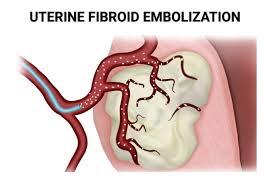How to Recover Quickly After Uterine Fibroid Embolization

Uterine fibroids are noncancerous growths in the uterus that can cause heavy menstrual bleeding, pelvic pain, bloating, and pressure on surrounding organs. For women seeking relief without major surgery, uterine fibroid embolization (UFE) has become a popular minimally invasive treatment option. While the procedure is highly effective, understanding the uterine fibroid embolization recovery process is essential to ensure quick healing, symptom relief, and optimal outcomes.
What is Uterine Fibroid Embolization
Uterine fibroid embolization involves blocking the blood flow to fibroids by introducing tiny embolic particles into the uterine arteries. This causes the fibroids to shrink over time, relieving pain and reducing bleeding. The procedure is performed by an interventional radiologist and requires only a small incision, usually in the groin or wrist, making it an outpatient treatment with a faster recovery compared to surgical options like hysterectomy or myomectomy.
Immediate Post-Procedure Care
The first few hours and days after UFE are critical for a smooth recovery. Most patients are monitored for a short period before being discharged. Common post-procedure symptoms include mild cramping, pelvic discomfort, and low-grade fever, which are typically manageable with prescribed or over-the-counter medications.
Tips for the first 24–48 hours include:
-
Rest and limited activity: Avoid strenuous tasks or heavy lifting to allow the body to heal.
-
Pain management: Use medications as prescribed to control discomfort.
-
Hydration: Drink plenty of fluids to help the body recover efficiently.
-
Monitor the incision site: Keep the area clean and dry, watching for signs of infection.
Managing Pain and Discomfort
Cramping or pelvic pressure is common after uterine fibroid embolization recovery. Applying a heating pad, taking warm baths, or wearing supportive clothing can help relieve discomfort. Avoiding activities that strain the abdominal area is essential, especially during the first week. Most women notice that pain and swelling gradually decrease within a few days to a week.
Gradual Return to Daily Activities
While UFE allows for a quicker recovery than surgery, patients should still follow a gradual approach to resuming normal routines. Light activities like walking can aid circulation and reduce the risk of blood clots, but high-impact exercise or heavy lifting should be postponed until cleared by a physician. Most women can return to work and routine activities within a week or two, depending on their individual recovery pace.
Nutrition and Lifestyle for Faster Recovery
Maintaining a healthy diet and proper hydration supports healing and overall wellness. Foods rich in fiber help prevent constipation, which can reduce pressure on the uterus and surrounding organs. Incorporating gentle exercise, avoiding prolonged sitting, and managing stress also contribute to a smoother uterine fibroid embolization recovery.
Follow-Up and Long-Term Care
Follow-up visits are essential to monitor fibroid shrinkage and ensure the procedure’s effectiveness. Imaging studies such as ultrasound or MRI may be conducted to assess the results. Patients should promptly report any unusual symptoms like excessive bleeding, severe pain, or fever to their healthcare provider.
Adopting long-term healthy habits, including regular exercise, balanced nutrition, and avoiding smoking, can enhance vascular and uterine health, reducing the likelihood of future fibroid issues. Techniques used in Peripheral Vascular Arterial procedures, which also focus on blood flow management, highlight the importance of maintaining vascular health for overall recovery and long-term wellness.
Conclusion
Recovering quickly after uterine fibroid embolization requires a combination of rest, proper pain management, gradual activity, and lifestyle adjustments. By following these guidelines and maintaining regular follow-up care, women can experience significant relief from fibroid-related symptoms while minimizing complications.
Understanding the uterine fibroid embolization recovery process empowers patients to take an active role in their healing journey, ensuring a smooth recovery, improved comfort, and long-lasting results.
- Art
- Causes
- Crafts
- Dance
- Drinks
- Film
- Fitness
- Food
- Spellen
- Gardening
- Health
- Home
- Literature
- Music
- Networking
- Other
- Party
- Religion
- Shopping
- Sports
- Theater
- Wellness



